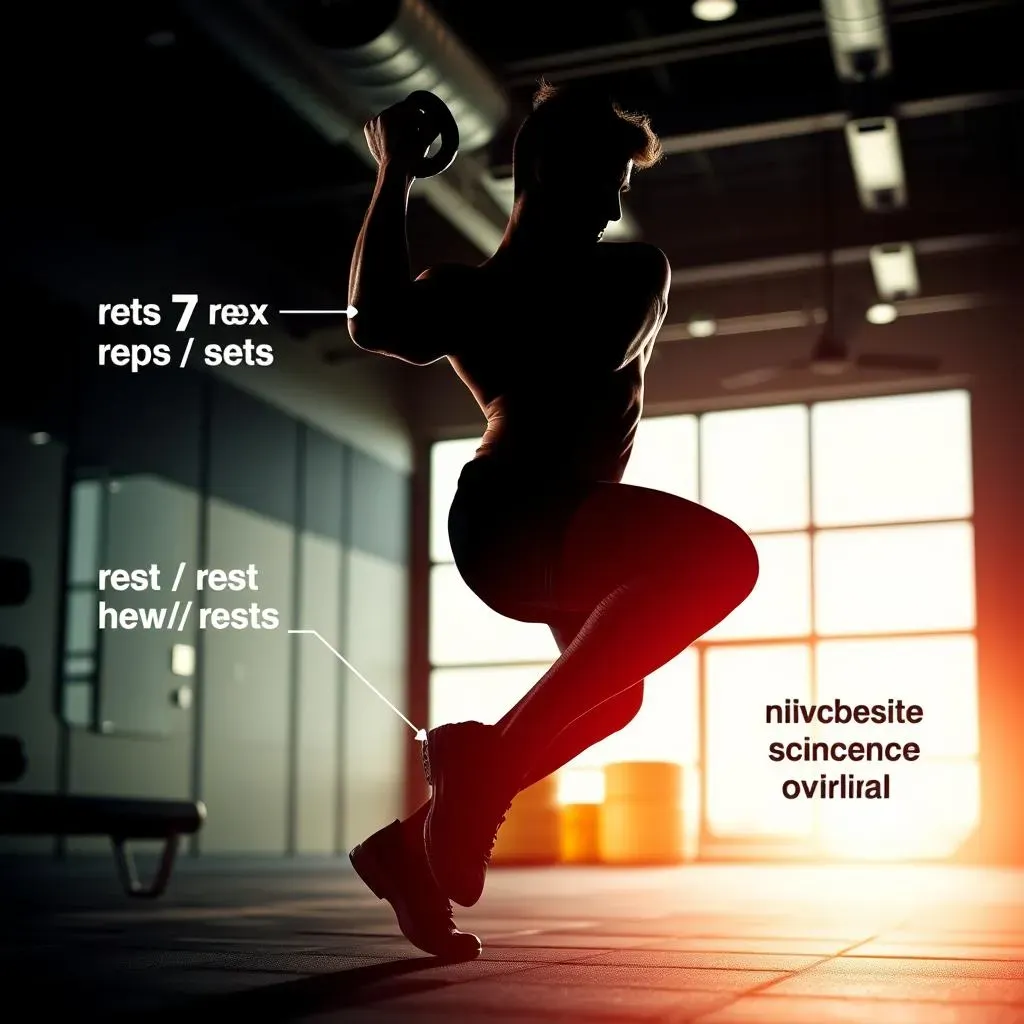Table of Contents
Tired of crowded gyms and complicated routines? What if you could torch calories, build serious muscle, and boost your overall fitness with just one piece of equipment? Enter the **one kettlebell full body workout**. This isn't just another fitness fad; it's a time-efficient, incredibly effective way to transform your body from head to toe.
Why Choose a One Kettlebell Full Body Workout?

Why Choose a One Kettlebell Full Body Workout?
so you're curious about kettlebells, huh? Let me tell you, ditching the overwhelming gym setup for a single kettlebell is a total game-changer. Why? Because it's efficient, effective, and surprisingly versatile. Think about it: no more hopping between machines or waiting for equipment. Just grab your kettlebell and get ready for a full-body blast.
The beauty of a kettlebell lies in its offset center of gravity. This forces your body to work harder to stabilize and control the weight, engaging more muscles with every single rep. You are not just lifting weight; you're also improving your balance, coordination, and core strength. Plus, kettlebell exercises often involve dynamic, compound movements, meaning you're hitting multiple muscle groups simultaneously and torching calories like crazy. It's like getting a strength and cardio workout all in one go!
Still not convinced? Consider the convenience factor. You can do a kettlebell workout practically anywhere – your living room, the park, even a hotel room. No more excuses about not having time or access to a gym. A single kettlebell opens up a world of workout possibilities, making it easier than ever to stay consistent with your fitness goals.
7 Key Exercises for Your Kettlebell Full Body Workout

7 Key Exercises for Your Kettlebell Full Body Workout
The Foundation: Lower Body Power
Alright, let's dive into the meat of the workout! We're going to cover seven essential exercises that'll hit every major muscle group. First up, legs and glutes! The **Goblet Squat** is your new best friend. Hold the kettlebell close to your chest, like you're cradling a baby, and squat down low, keeping your back straight and chest up. This variation really forces you to engage your core and maintain good posture. Aim for 3 sets of 10-12 reps.
Next, we're hitting the **Kettlebell Swing**. This isn't just an arm exercise; it's a full-body power move that targets your posterior chain (glutes, hamstrings, and back). Hinge at your hips, keep your back flat, and hike the kettlebell back between your legs, then explode forward, driving with your hips to swing the kettlebell up to chest height. Think of it as a controlled ballistic movement. Start with 3 sets of 15-20 reps.
Exercise | Sets | Reps | Focus |
|---|---|---|---|
Goblet Squat | 3 | 10-12 | Quads, Glutes, Core |
Kettlebell Swing | 3 | 15-20 | Posterior Chain, Cardio |
Upper Body and Core Strength
Time to work that upper body! The **Single-Arm Overhead Press** is a fantastic exercise for building shoulder strength and stability. Stand with your feet shoulder-width apart, and press the kettlebell overhead, locking out your elbow at the top. Keep your core engaged to prevent leaning to one side. Do 3 sets of 8-10 reps per arm.
Now, let's target those back muscles with the **Kettlebell Single-Arm Row**. Hinge at your hips, keeping your back flat and core engaged. Let the kettlebell hang down, then pull it up towards your chest, squeezing your shoulder blade. This exercise is great for improving posture and building upper back strength. Aim for 3 sets of 10-12 reps per arm.
- Single-Arm Overhead Press: 3 sets of 8-10 reps per arm
- Kettlebell Single-Arm Row: 3 sets of 10-12 reps per arm
Mastering Form: Technique Tips for Each Kettlebell Exercise

Mastering Form: Technique Tips for Each Kettlebell Exercise
The Foundation: Mastering the Hinge
listen up! Before you start slinging that kettlebell around like a madman, let's talk about form. Because honestly, bad form is a one-way ticket to injury-ville. The most crucial movement to nail is the hip hinge. This is the foundation for so many kettlebell exercises, especially the swing.
Think of the hip hinge as a controlled bend at the hips, not a squat. Your back should stay flat, like you're holding a tray of drinks, and your core should be engaged. Imagine you're closing a car door with your butt. It might sound silly, but it helps! Practice this movement with a broomstick or dowel rod along your back to ensure you're maintaining proper alignment. Trust me, getting this right will save you a lot of pain and frustration down the road.
A common mistake is squatting too much during the swing, which shifts the focus from the posterior chain to the quads. Remember, the power comes from your hips, not your knees. Another mistake is rounding the back, which can lead to serious back injuries. Keep that back flat and your core tight!
Overhead Movements: Stability is Key
Now, let's talk about overhead movements like the Single-Arm Overhead Press and the Overhead Reverse Lunge. These exercises require a lot of shoulder stability, so it's important to build up to them gradually. Start with lighter weights and focus on controlled movements.
For the Overhead Press, think about packing your shoulder. This means engaging your lats and pulling your shoulder blade down and back. This will create a more stable base for the press and prevent shoulder impingement. Also, be sure to keep your core engaged to prevent leaning to one side.
With the Overhead Reverse Lunge, maintaining balance is key. Keep your eyes focused on a fixed point in front of you and engage your core. Step back into the lunge, keeping your front knee behind your toes. Lower your back knee towards the ground, but don't let it touch. Then, push off with your front foot to return to the starting position.
Exercise | Common Mistake | Form Tip |
|---|---|---|
Kettlebell Swing | Squatting too much | Focus on hinging at the hips |
Single-Arm Overhead Press | Leaning to one side | Engage your core and pack your shoulder |
Overhead Reverse Lunge | Losing balance | Focus on a fixed point and engage your core |
Breathing and Bracing: Your Secret Weapons
Finally, don't underestimate the power of proper breathing and bracing. Before each rep, take a deep breath into your belly, not your chest, and brace your core like you're about to get punched. This will create intra-abdominal pressure, which will stabilize your spine and allow you to lift heavier weights safely.
Exhale during the most challenging part of the exercise. For example, exhale as you swing the kettlebell up or as you press it overhead. This will help you maintain control and power throughout the movement.
Remember, form is paramount. It's better to start with lighter weights and master the technique than to go too heavy and risk injury. Pay attention to your body and don't be afraid to ask a qualified trainer for help.
Building Your One Kettlebell Full Body Workout Plan

Building Your One Kettlebell Full Body Workout Plan
Crafting Your Weekly Schedule
so you've got the exercises down. Now, how do you piece it all together into a solid workout plan? The key is to think about frequency, intensity, and volume. I recommend starting with 2-3 full-body kettlebell workouts per week, with rest days in between to allow your muscles to recover.
On your workout days, you can either perform the exercises in a circuit format (moving from one exercise to the next with minimal rest) or as straight sets (completing all sets of one exercise before moving on to the next). I personally prefer circuits for their cardio benefits, but straight sets can be great for focusing on strength development. Experiment and see what works best for you!
Workout Style | Description | Benefits |
|---|---|---|
Circuit Training | Perform exercises back-to-back with minimal rest. | Increased cardio, time-efficient |
Straight Sets | Complete all sets of one exercise before moving to the next. | Focus on strength development, allows for heavier weights |
Sample Weekly Plan
Here's a sample weekly plan to get you started:
* **Monday:** Kettlebell Full Body Workout * **Tuesday:** Rest or Active Recovery (yoga, light cardio) * **Wednesday:** Kettlebell Full Body Workout * **Thursday:** Rest * **Friday:** Kettlebell Full Body Workout * **Saturday:** Rest or Active Recovery * **Sunday:** Rest
Remember, this is just a template. Feel free to adjust it based on your own schedule and fitness level. The most important thing is to be consistent and listen to your body. If you're feeling overly sore or fatigued, take an extra rest day.
Progressing Your One Kettlebell Full Body Workout for Maximum Results

Progressing Your One Kettlebell Full Body Workout for Maximum Results
Increase Reps and Sets
Alright, so you've been crushing your kettlebell workouts for a few weeks now. You're feeling stronger, more energetic, and maybe even noticing some changes in the mirror. Awesome! But here's the thing: your body is incredibly adaptable. If you keep doing the same workout, eventually, it'll stop challenging you, and you'll plateau. That's where progressive overload comes in.
The simplest way to progress is by gradually increasing the number of reps and sets you're performing. If you started with 3 sets of 10 reps for each exercise, try bumping it up to 3 sets of 12 or even 15 reps. Once you can comfortably perform that, add another set. Small, incremental increases over time will lead to significant gains in strength and endurance.
Decrease Rest Times
Another effective way to ramp up the intensity is by shortening your rest periods between sets. If you've been resting for a full minute between sets, try cutting it down to 45 seconds, then 30 seconds. This will not only make your workouts more challenging but also improve your cardiovascular fitness.
Decreasing rest times forces your body to recover more quickly and efficiently. It also adds a metabolic component to your workout, helping you burn more calories and improve your overall work capacity. Just be sure to maintain good form, even as you get fatigued.
Progression Method | Description | Benefits |
|---|---|---|
Increase Reps | Gradually add more repetitions to each set. | Builds muscular endurance and hypertrophy. |
Increase Sets | Gradually add more sets to each exercise. | Increases overall workout volume and strength gains. |
Decrease Rest | Shorten the rest periods between sets. | Improves cardiovascular fitness and metabolic conditioning. |
Increase the Weight
Eventually, you'll reach a point where increasing reps and decreasing rest times just aren't cutting it anymore. That's when it's time to grab a heavier kettlebell. This is the most direct way to challenge your muscles and force them to adapt.
When increasing the weight, start small. Even a 2-4 kg increase can make a big difference. Focus on maintaining perfect form, even with the heavier weight. If your form starts to break down, it's a sign that you're not ready to move up in weight. Remember, safety first!
Don't be afraid to experiment with different progression methods to find what works best for you. The key is to consistently challenge your body and avoid plateaus. With a little creativity and effort, you can keep seeing results from your one kettlebell full body workout for years to come!
Your One Kettlebell Full Body Workout: A Path to Strength and Simplicity
The beauty of the one kettlebell full body workout lies in its simplicity and effectiveness. With just a single piece of equipment, you can target every major muscle group, improve your cardiovascular fitness, and build functional strength that translates to everyday life. Remember to prioritize proper form, listen to your body, and progressively increase the challenge as you get stronger. So, pick up that kettlebell and start your journey towards a fitter, stronger you today!